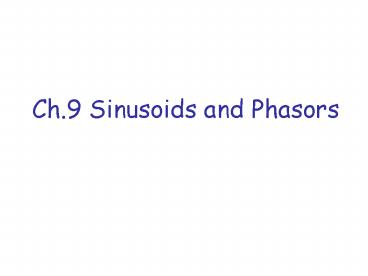Ch.9 Sinusoids and Phasors - PowerPoint PPT Presentation
1 / 28
Title:
Ch.9 Sinusoids and Phasors
Description:
AC is more efficient and economical to transmit over long distance. Sinusoid is a signal that has the form of the sine or cosine function ... – PowerPoint PPT presentation
Number of Views:1213
Avg rating:3.0/5.0
Title: Ch.9 Sinusoids and Phasors
1
Ch.9 Sinusoids and Phasors
2
1. Introduction
- AC is more efficient and economical to transmit
over long distance - Sinusoid is a signal that has the form of the
sine or cosine function - Sinusoidal current alternating current (ac)
- Nature is sinusoidal
- Easy to generate and transmit
- Any practical periodic signal can be represented
by a sum of sinusoids - Easy to handle mathematically
3
2. Sinusoids
- Consider the sinusoidal voltage
- T period of the sinusoid
4
Sinusoids (2)
- Periodic function
- Satisfies f(t) f(tnT), for all t and for all
integers n - Hence
- Cyclic frequency f of the sinusoid
5
Sinusoids (3)
- Let us examine the two sinusoids
- Trigonometric identities
6
Sinusoids (4)
- Graphical approach
- Used to add two sinusoids of the same frequency
- where
7
Example 9.1
- Find the amplitude, phase, period, and frequency
of the sinusoid
8
Example 9.2
- Sol)
9
3. Phasors
- Phasor is a complex number that represents the
amplitude and phase of a sinusoid - Provides a simple means of analyzing linear
circuits excited by sinusoidal sources - Complex number
- with
10
Phasors (2)
- Operations of complex number
- Addition
- Subtraction
- Multiplication
- Division
- Reciprocal
- Square Root
- Complex Conjugate
11
Phasors (3)
- Eulers identity
- with
- Given a sinusoid
- Thus, where
- Plot of the
12
Phasors (4)
- Phasor representation of the sinusoid v(t)
13
Phasors (5)
- Derivative integral of v(t)
- Derivative of v(t)
- Phasor domain representation of derivative v(t)
- Phasor domain rep. of Integral of v(t)
14
Phasors (6)
- Summing sinusoids of the same frequency
- Differences between v(t) and V
- v(t) is time domain representation, while V is
phasor domain rep. - v(t) is time dependent, while V is not
- v(t) is always real with no complex term, while V
is generally complex - Phasor analysis
- Applies only when frequency is constant
- Applies in manipulating two or more sinusoidal
signals only if they are of the same frequency
15
Example 9.3
- Evaluate these complex numbers
- Sol)
- a)
- then
- Taking the square root
16
Example
- Example 9.4
- Transform these sinusoids to phasors
- Example 9.5
- Find the sinusoids represented by these phasors
17
Example
- Example 9.6
- Example 9.7
- Using the phasor approach, determine the current
i(t)
18
4. Phasor Relationships for Circuit Elements
- Voltage-current relationship
- Resistor ohms law
- Phasor form
- Inductor
- Phasor form
19
Phasor Relationships for Circuit Elements(2)
- Inductor
- The current lags the voltage by 90o.
- Capacitor
- Phasor form
- The current leads the voltage by 90o.
20
Example 5.6
- The voltage v12cos(60t45o) is applied to a 0.1H
inductor. Find the steady-state current through
the inductor - Sol)
- Converting this to the time domain,
21
5. Impedance and Admittance
- Voltage-current relations for three passive
elements - Ohms law in phasor form
- Imdedance Z of a circuit is the ratio of the
phasor voltage to the phasor current I, measured
in ohms - When ,
- When ,
22
Impedance and Admittance (2)
- Impedance Resistance j Reactance
- where
- Adimttance Y is the reciprocal of impedance,
measured in siemens (S) - Admittance Conductance j Susceptance
23
Example 9.9
- Find v(t) and i(t) in the circuit
- Sol)
- From the voltage source
- The impedance
- Hence the current
- The voltage across the capacitor
24
6. Kirchhoffs law in the frequency domain
- For KVL,
- Then,
- KVL holds for phasors
- KCL holds for phasors
- Time domain
- Phasor domain
- KVL KCL holds in frequency domain
25
7. Impedance Combinations
- Consider the N series-connected impedances
- Voltage-division relationship
26
Impedance Combinations (2)
- Consider the N parallel-connected impedances
- Current-division relationship
27
Example 9.10
- Find the input impedance of the circuit with w50
rad/s - Sol)
- The input impedance is
28
Example 9.11
- Determine vo(t) in the circuit
- Sol)
- Time domain ? frequency domain
- Voltage-division principle






























